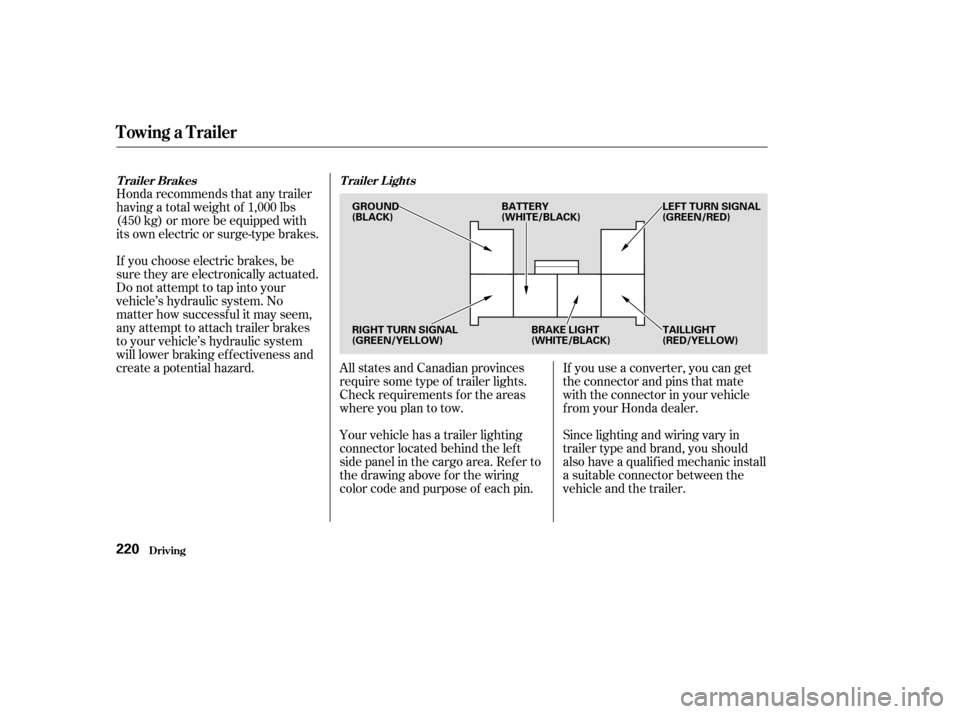Page 63 of 374

Together, airbags and
seat belts provide the best
protection.
Tampering could cause
the airbags to deploy, possibly
causing very serious injury. See page f or f urther inf ormation
and precautions relating to your
airbags.
If rain or spilled water
soaks into a seat-back, it can
prevent the side airbag system
f rom working properly. Improperly
replacing or covering f ront seat-
back covers can prevent your side
airbags f rom inf lating during a
collision.
Any
airbag that has deployed must be
replaced along with the control
unit, automatic seat belt
tensioners, and other related parts.
Do not try to remove or replace
anyairbagbyyourself.Thismust
be done by a Honda dealer or a
knowledgeable body shop.
Your f ront and side airbag systems
(if equipped) are virtually
maintenance-f ree, and there are no
parts you can saf ely service.
However, you must have your
vehicle serviced if:
Take your vehicle to
an authorized Honda dealer as
soon as possible. If you ignore this
indication, the airbags might not
inf late when you need them. 192
Airbag Service
Additional Saf ety Precautions
Donotattempttodeactivateyour
airbags.
Do not t amper wit h airbagcomponent s or wiring f or anyreason.
Do not expose t he f ront seat -backsto water. Do not cover or replace f ront seat -
back covers wit hout consult ing aHonda dealer.
Your airbags ever inf late.
T he SRS indicat or light alert s yout o a problem.
Additional Inf ormation About Your Airbags
Driver and Passenger Saf ety59
Page 224 of 374

Honda recommends that any trailer
having a total weight of 1,000 lbs
(450 kg) or more be equipped with
its own electric or surge-type brakes.
If you choose electric brakes, be
sure they are electronically actuated.
Do not attempt to tap into your
vehicle’s hydraulic system. No
matter how successf ul it may seem,
any attempt to attach trailer brakes
to your vehicle’s hydraulic system
will lower braking ef f ectiveness and
create a potential hazard.Your vehicle has a trailer lighting
connector located behind the lef t
side panel in the cargo area. Ref er to
thedrawingaboveforthewiring
color code and purpose of each pin. All states and Canadian provinces
require some type of trailer lights.
Check requirements f or the areas
where you plan to tow.If you use a converter, you can get
the connector and pins that mate
with the connector in your vehicle
f rom your Honda dealer.
Since lighting and wiring vary in
trailer type and brand, you should
also have a qualif ied mechanic install
a suitable connector between the
vehicle and the trailer.
Trailer Brakes
Trailer Lights
Towing a Trailer
Driving220
GROUND
(BLACK) LEFT TURN SIGNAL
(GREEN/RED)
RIGHT TURN SIGNAL
(GREEN/YELLOW) BRAKE LIGHT
(WHITE/BLACK)TAILLIGHT
(RED/YELLOW)
BATTERY
(WHITE/BLACK)
Page 308 of 374

Use a high-pressure spray to clean
the underside of your vehicle. This
is especially important in areas
that use road salt in winter. It is
also a good idea in humid climates
and areas subject to salt air.
Vehicles equipped with ABS have
a sensor and wiring at each wheel.
Be careful not to damage them.
Many corrosion-preventive measures
are built into your Honda. You can
help keep your vehicle f rom
corroding by perf orming some
simple periodic maintenance:
Repair chips and scratches in the
paint as soon as you discover them.
Two f actors normally contribute to
causing corrosion in your vehicle:
Moisture trapped in body cavities.
Dirtandroadsaltthatcollectsin
hollows on the underside of the
vehicle stays damp, promoting
corrosion in that area.
Removal of paint and protective
coatings f rom the exterior and
underside of the vehicle. Inspect and clean out the drain
holes in the bottom of the doors
and body.
Check the f loor coverings f or
dampness. Carpeting and f loor
mats may remain damp f or a long
time, especially in winter. This
dampness can eventually cause
the f loor panels to corrode.Have the corrosion-preventive
coatings on the underside of your
vehicle inspected and repaired
periodically.
1.
2.
Corrosion Prot ect ion
Appearance Care304